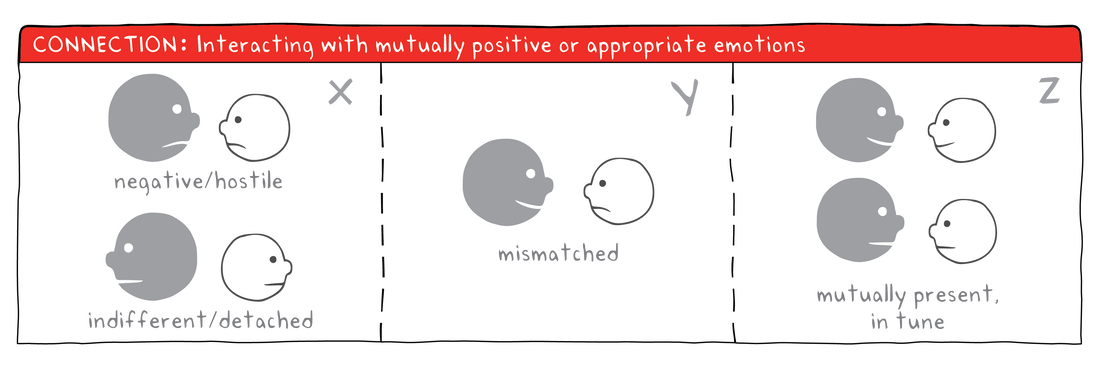connection
When you observe people together, whether 1-on-1 or in a group, you often get an intuitive sense of whether they seem connected or disconnected, really "with" each other or distant.
We identify three common modes of mutual emotional expressions in an interaction.
In cultures where people are uncomfortable with negative expressions of emotions, it can be tempting to judge “X” or even “Y” as indicators of a “bad interaction”. In fact, observational and assessment tools (e.g., classroom quality assessment, teacher evaluation) often assign lower scores to moments of negative feelings or mismatched connections. In our fieldwork and research, we find that it is very natural and human to move through different modes of emotional connection either within a short interaction or over time. While it is not desirable to be permanently stuck in “disconnect” or “detachment”, it is not necessary to permanently reside in “happily ever after” mutual attunement either. What is developmental is to be able to move between disconnect and connect (what some early childhood scholars call “rupture and repair”).
By the way, we found this to be true for X, Y, Z modes across all four dimensions, which is why we started to use dashed lines between modes in the 2019 edition, rather than rigid, solid boundaries we used in earlier versions.
We identify three common modes of mutual emotional expressions in an interaction.
- X: The adult and child(ren) interact with each other in a negative or hostile way, or there is a sense of distance and detachment between the adult and child(ren).
- Y: The adult and child(ren) appear unmatched emotionally, with one side more enthused, positive, or expressive than the other.
- Z: The adult and child(ren) are mutually present or in tune with one another, whether sharing positive affect or attentiveness and awareness.
In cultures where people are uncomfortable with negative expressions of emotions, it can be tempting to judge “X” or even “Y” as indicators of a “bad interaction”. In fact, observational and assessment tools (e.g., classroom quality assessment, teacher evaluation) often assign lower scores to moments of negative feelings or mismatched connections. In our fieldwork and research, we find that it is very natural and human to move through different modes of emotional connection either within a short interaction or over time. While it is not desirable to be permanently stuck in “disconnect” or “detachment”, it is not necessary to permanently reside in “happily ever after” mutual attunement either. What is developmental is to be able to move between disconnect and connect (what some early childhood scholars call “rupture and repair”).
By the way, we found this to be true for X, Y, Z modes across all four dimensions, which is why we started to use dashed lines between modes in the 2019 edition, rather than rigid, solid boundaries we used in earlier versions.
connection in motion
|
|
|
|


